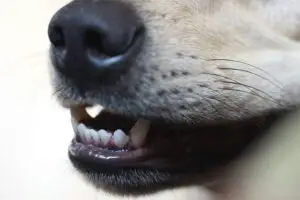The question of what to do if my dog ate dental floss, can be summed up as ‘Don’t Panic’
It is important to take your dog to the vet when they have eaten something that could be harmful, but should you worry if they ate some floss?
Main Considerations
Some dogs may be allergic or sensitive to the dental floss.
However, most dogs will just vomit and recover quickly! They have strong stomach acids that kill any bacteria or parasites.
Remember, you’re not going to find a needle in a haystack because hay doesn’t hide anything! That is why it is so important for you to take care of your pet by getting them immediate veterinary if in any doubt about the situation.
A dog will often swallow enough floss to be uncomfortable but not enough to cause any harm. If your dog did not vomit right away or they are gasping for breath, then call the vet immediately.
The biggest problem I see with dogs swallowing floss is that they may become constipated and have difficulty passing it- especially if the dog is a puppy.
Pet owners should never attempt to cause their dog to pass stool by giving them laxatives or even food. It can cause severe complications, and your dog could die if not treated immediately by a veterinarian.
Things To Try at Home
If your furry friend has swallowed some dental floss, your first instinct may be to head to the vet for emergency care. But if you don’t have the time or money for that, you can try a few things at home.
If it is possible to get a good grip on the floss, try removing it from your dog’s mouth.
Take caution if you are attempting this and be prepared in case your dog reacts aggressively. You might want to use some gloves as well.
If the floss is hooked around your pet’s teeth, try gently manoeuvring it out of his mouth by taking a hold of the end that isn’t wrapped around the tooth.
Don’t force it or jerk it out because doing so could worsen your dog’s oral health problems and even cause injury to yourself in the process.
Don’t punish your pet for eating dental floss just because he couldn’t help himself with an urge that he had no control over.
Inspect the dog’s mouth and paw at every opportunity for any evidence of dental floss. Then, if you have not been able to remove the floss, try to induce vomiting.
If the amount of floss swallowed is very small—too small to see, let alone remove, in any significant quantity—it may be difficult to find.
And, even if it’s easy to remove, you might not be able to recover all of it. For those instances when you can find it and still save your dog’s life, read on for some other tips.
1) Don’t Allow Your Pet Outside Until the Floss Is Removed
Dogs can swallow a lot of things that are not food but can still harm them. When staying home is an option, you should keep your pet indoors until you are certain that the floss is nowhere in sight or has been removed.
2) Keep Your Pet Hydrated and Let Them Rest
It’s really important that your pet drink some fluids as soon as possible after swallowing the floss, even if you don’t think he ingested enough to cause harm.
If your dog isn’t already eating, it’s also a good idea to offer him water or other non-sugar liquids such as broth or gravy.
If your pet vomits, be sure she drinks enough fluids so that she can continue to vomit and keep herself hydrated.
If they’re in pain or their belly is distended, be sure they rest comfortably—even if they’re otherwise feeling OK.
3) Try to Extract the Floss Through Vomiting
i. Make a Hydrogen Peroxide Solution: In a bowl or jar, create a 3% food-grade Hydrogen Peroxide solution.
ii. Stir well and get ready to pour a little bit of the mixture into your dog’s mouth so that they will be inclined to lick it off their tongue and gums.
You want to make sure they don’t choke on the solution, so the best way to do this is to use a syringe or eyedropper and squirt just a small amount of it into your dog’s mouth.
They will swallow it on their own and then lick off the rest.
iii. After your dog has swallowed a little bit of the solution, this should induce vomiting shortly after..
iv. Watch your dog carefully once you have put the solution in their mouth and allowed them to lick it off their tongue and gums a bit.If it doesn’t work, try again later on.
v. Once they have finished vomiting, check the vomit for signs of the floss.
vi. Once your dog is all done throwing up, either speak to a vet over the phone or if possible. bring them into the vet and get them checked out.
4) Wrap Them in a Blanket and Get them to a Vet Immediately If You Can’t Find All the Floss
If you have no way of removing more than a few inches of dental floss when inspecting your dog’s mouth yourself, take them to their veterinarian right away.
It’s possible that much more has been swallowed—even if it’s tiny.
After vomiting, your dog may also be in intense pain. It’s best to get them to a vet as soon as possible.
5) Make Sure You Give Your Pet Plenty of Tender Loving Care After the Event
Give your pet a little extra attention after the ordeal. Let him rest, keep them out of trouble, and apply some soothing ointment to their mouth to soothe any irritation.
How to prevent your dog from eating Dental Floss?
The best way to stop your dog from eating dental floss is to be watchful and mindful of where your dog has free access.
Keep in mind that anything could be a potential hazard for dogs, even things you might not expect, such as small household plants or medications or items with a strong odor.
Place the floss in a locked container when you aren’t using it or keep it out of reach from pets by placing it up high on the bathroom counter without attracting attention.
Gently take away the temptation by using a creative way to put the floss out of reach. Make sure the dog doesn’t have access to any other place that might be an alternative access route.
Other Points to Consider:
1. Because pieces of dental floss can cause real harm to your dog, try to prevent him from swallowing it in the first place.
If he seems to have an obsession with dental floss, consider removing it from his environment, whether that is by storing it in a secure container or by not allowing him access to it at all.
Dogs that eat dental floss can have a variety of health problems ranging from coughing of swollen and painful gums to vomiting.
In rare instances where your pet will not be able to respond to the above methods and you are faced with a situation where you need to take your pet to the vet.
2. Only try to remove dental floss from the mouth of your dog when it is safe to do so.
It is very easy for a curious dog to swallow even small pieces of dental floss, and even if your dog is unharmed it can leave them with a dangerous blockage in the digestive tract, or worse.
3. If your dog does chew on dental floss, and you know he has a habit of swallowing things that shouldn’t be chewed on, there are steps you can take to prevent him from chewing on this or other objects.
4. If your dog is a constant chewer, then consider getting them some toys to keep them busy.
Remember to choose toys that cannot be torn apart and put in the mouth, such as stuffed animals or even a steak bone.
These are great for keeping a dog busy and out of trouble.
5. Dental floss isn’t the only thing that dogs can swallow and choke on.
When a dog eats something, it will always have a way to get it out of its mouth. When a dog swallows an improper object, it could block the airway or cause choking.
To help your pet get the object out safely, try to do so with your hand or finger and if it won’t go down their throat, then you can offer them some water and gently massage their throat to help release the object.
6. Keeping your dog safe from dangerous items that can be found around the house is best.
Don’t allow your dog to roam freely through a home where he could find dangers, such as sharp objects or small toys.
Prevent them from chewing on harmful objects by applying a bitter-tasting liquid to the objects you are not comfortable with them having access to.
Conclusion
Dental floss can be dangerous to your pet if it is ingested. It can lead to various health issues, including choking and intestinal blockage.
If you want to keep this from happening, make sure you use a lockable container when you are using the floss and keep it out of your dog’s reach at all times.
It’s also important to remember that in most cases, your pet can (usually) vomit things up on their own.
If your dog has ingested dental floss and you follow these steps to get it out, he should be fine. Do not let this article scare you.
Most dogs will be fine after vomiting, even without medical attention. However, if after taking the steps mentioned above your dog is not able to vomit on its own then you should take them to the vet right away.
All in all, have a backup plan just in case. That way you will feel more at ease about your dog’s health and welfare if they do end up swallowing a piece of dental floss or some other foreign object that can cause choking or intestinal blockage.

